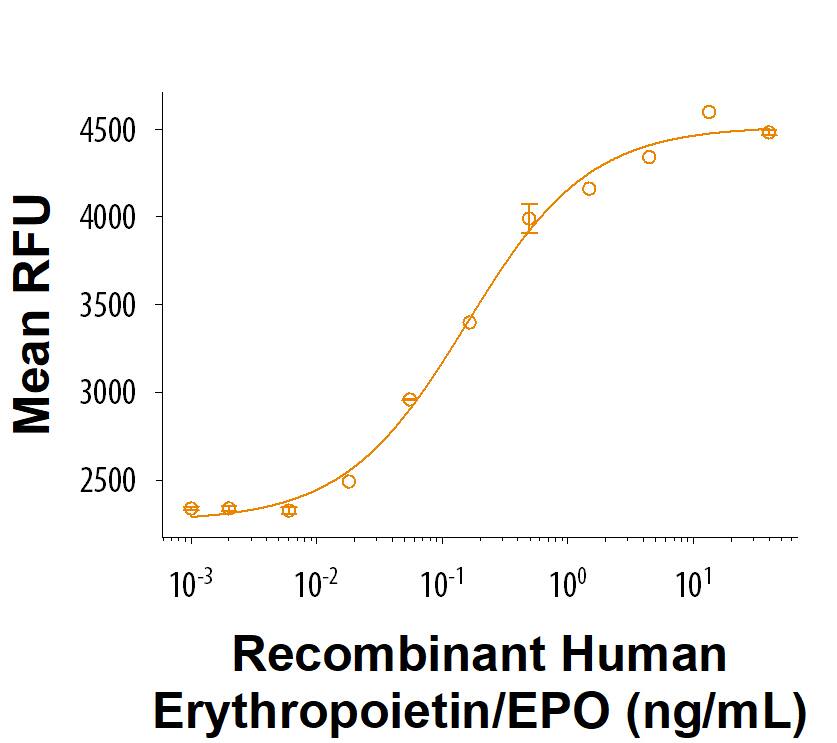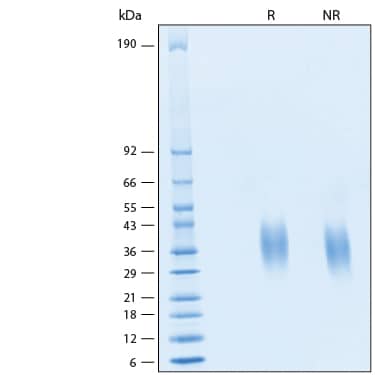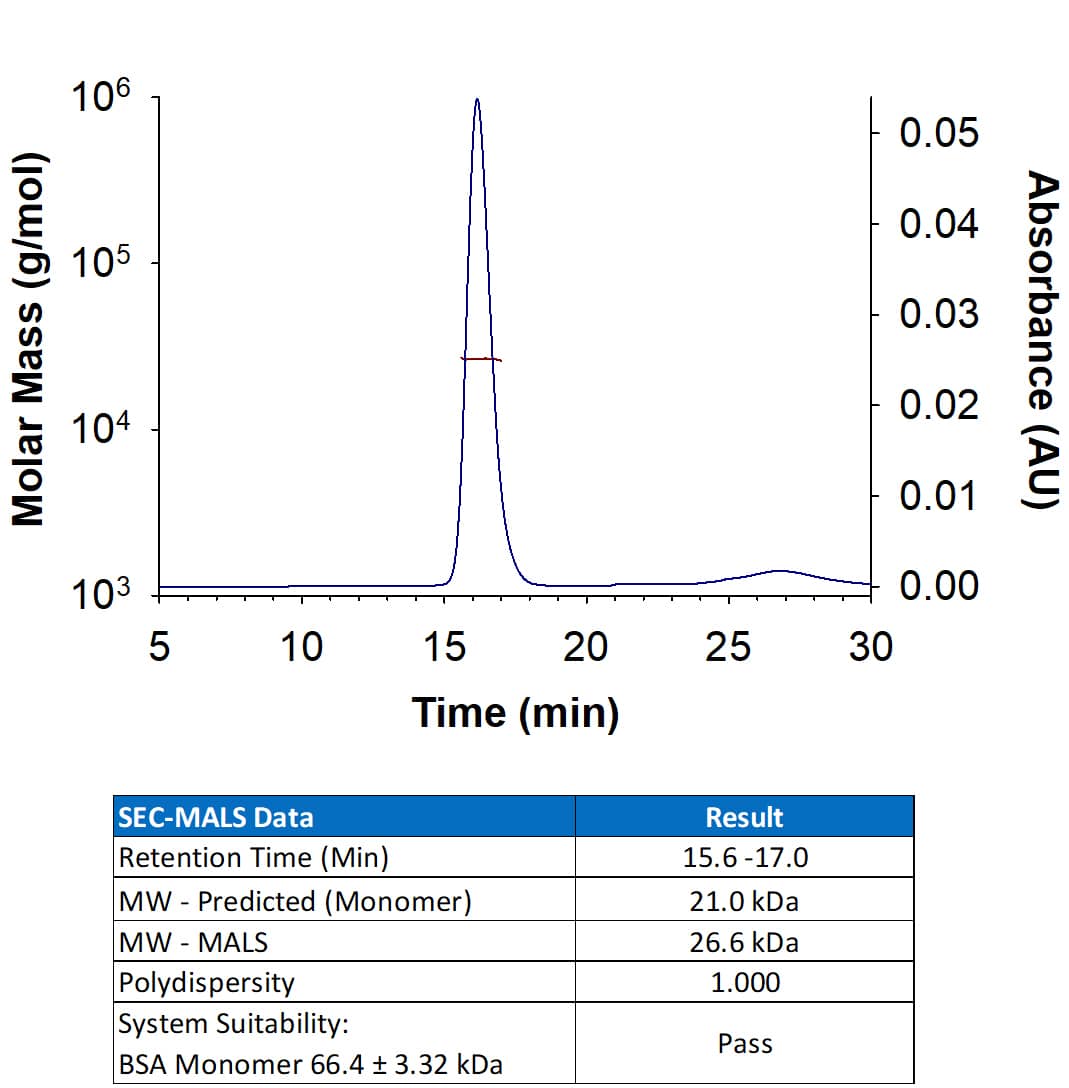Recombinant Human Erythropoietin/EPO Protein, CF
R&D Systems, part of Bio-Techne | Catalog # 11264-TC

Key Product Details
- R&D Systems CHO-derived Recombinant Human Erythropoietin/EPO Protein (11264-TC)
- Quality control testing to verify active proteins with lot specific assays by in-house scientists
- All R&D Systems proteins are covered with a 100% guarantee
Product Specifications
Source
Ala28-Arg193
Purity
Endotoxin Level
Predicted Molecular Mass
SDS-PAGE
Activity
Scientific Data Images for Recombinant Human Erythropoietin/EPO Protein, CF
Recombinant Human Erythropoietin/EPO Protein SEC-MALS.
Recombinant Human Erythropoietin/EPO (Catalog # 11264-TC) has a molecular weight (MW) of 26.6 kDa as analyzed by SEC-MALS, suggesting that this protein is a monomer. MW may differ from predicted MW due to post-translational modifications (PTMs) present (e.g. Glycosylation).Recombinant Human Erythropoietin/EPO Protein Bioactivity.
Measured in a cell proliferation assay using TF‑1 human erythroleukemic cells. Kitamura, T. et al. (1989) J. Cell Physiol. 140:323. The ED50 for this effect is 0.075-0.750 ng/mL.Recombinant Human Erythropoietin/EPO Protein SDS-PAGE.
2 μg/lane of Recombinant Human Erythropoietin/EPO Protein (Catalog # 11264-TC) was resolved with SDS-PAGE under reducing (R) and non-reducing (NR) conditions and visualized by silver staining, showing bands at 33-41 kDa.Formulation, Preparation and Storage
11264-TC
| Formulation | Lyophilized from a 0.2 μm filtered solution in PBS with Trehalose. |
| Reconstitution | Reconstitute at 100-500 μg/mL in PBS. |
| Shipping | The product is shipped at ambient temperature. Upon receipt, store it immediately at the temperature recommended below. |
| Stability & Storage | Use a manual defrost freezer and avoid repeated freeze-thaw cycles.
|
Background: Erythropoietin/EPO
Erythropoietin (EPO) is a 34 kDa glycoprotein hormone in the type I cytokine family and is related to thrombopoietin (1). Its three N-glycosylation sites, four alpha helices, and N- to C-terminal disulfide bond are conserved across species (2, 3). Glycosylation of the EPO protein is required for biological activities in vivo (4). The mature human EPO protein shares 75% - 84% amino acid sequence identity with bovine, canine, equine, feline, mouse, ovine, porcine, and rat EPO. EPO is primarily produced in the kidney by a population of fibroblast-like cortical interstitial cells adjacent to the proximal tubules (5). It is also produced in much lower, but functionally significant amounts by fetal hepatocytes and in adult liver and brain (6-8). EPO promotes erythrocyte formation by preventing the apoptosis of early erythroid precursors which express the erythropoietin receptor (EPO R) (8, 9). EPO R has also been described in brain, retina, heart, skeletal muscle, kidney, endothelial cells, and a variety of tumor cells (7, 8, 10, 11). Ligand induced dimerization of EPO R triggers JAK2-mediated signaling pathways followed by receptor/ligand endocytosis and degradation (1, 12). Rapid regulation of circulating EPO allows tight control of erythrocyte production and hemoglobin concentrations. Anemia or other causes of low tissue oxygen tension induce erythropoietin production by stabilizing the hypoxia-induceable transcription factors HIF-1 alpha and HIF-2 alpha (1, 6). EPO additionally plays a tissue-protective role in ischemia by blocking apoptosis and inducing angiogenesis (7, 8, 13).
References
- Koury, M.J. (2005) Exp. Hematol. 33:1263.
- Jacobs, K. et al. (1985) Nature 313:806.
- Wen, D. et al. (1993) Blood 82:1507.
- Tsuda E., et al. (1990) Eur. J. Biochem. 188:405.
- Lacombe, C. et al. (1988) J. Clin. Invest. 81:620.
- Eckardt, K.U. and A. Kurtz (2005) Eur. J. Clin. Invest. 35 Suppl. 3:13.
- Sharples, E.J. et al. (2006) Curr. Opin. Pharmacol. 6:184.
- Rossert, J. and K. Eckardt (2005) Nephrol. Dial. Transplant 20:1025.
- Koury, M.J. and M.C. Bondurant (1990) Science 248:378.
- Acs, G. et al. (2001) Cancer Res. 61:3561.
- Hardee, M.E. et al. (2006) Clin. Cancer Res. 12:332.
- Verdier, F. et al. (2000) J. Biol. Chem. 275:18375.
- Kertesz, N. et al. (2004) Dev. Biol. 276:101.
Alternate Names
Gene Symbol
UniProt
Additional Erythropoietin/EPO Products
Product Documents for Recombinant Human Erythropoietin/EPO Protein, CF
Product Specific Notices for Recombinant Human Erythropoietin/EPO Protein, CF
For research use only


